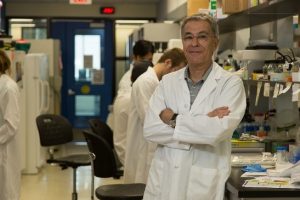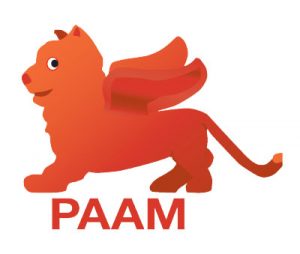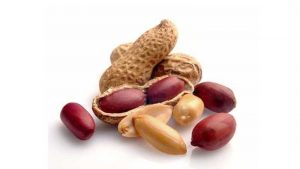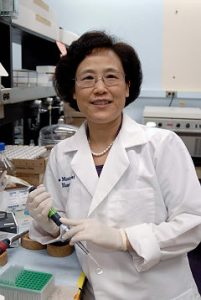View our recorded webinar with Dr. Manel Jordana on the science behind food allergy, discover the conferences we attended to keep up-to-date on research, learn more about the Ontario Government’s new announcement to support children with prevalent medical conditions (including anaphylaxis), and participate in an innovative twin study to help researchers look further into the genetic and environmental aspects of food allergy.
Plus, learn more about the latest in peanut research: read about the new gene associated with peanut allergy, and learn why the Viaskin® Peanut patch failed the phase 3 trial.
You can also read our latest installment in our allergy treatment spotlight. This month, we feature Dr. Xiu-Min Li and her Chinese herbal allergy remedies.
Recorded webinar: The research and science behind food allergy

Dr. Manel Jordana
Dr. Manel Jordana presented the research and basic science behind food allergy in a webinar with us earlier this month. The focus of the presentation was on the research for allergy prevention, allergy therapies, and what could potentially lead to a cure.
It was an insightful and educational session, we invite you to watch the webinar and share with others!
Watch the recorded webinar now!
Keeping up-to-date on research – the conferences we’ve attended this past month.
This past month, we attended two key conferences as a way to keep up-to-date on the latest research around allergy, including:
The Annual Canadian Society of Allergy and Clinical Immunology (CSACI) Scientific Meeting, October, Toronto, ON.
 The 72nd meeting of the Canadian Society of Allergy and Clinical Immunology brought together an outstanding array of Canadian and international speakers who shared their expertise and insights as they covered the wide spectrum of clinical and basic sciences. As the primary Canadian gathering for the allergy community, it provided an excellent opportunity for specialists and researchers in the field of allergy, asthma, and clinical immunology from Canada and around the world to meet and share their knowledge.
The 72nd meeting of the Canadian Society of Allergy and Clinical Immunology brought together an outstanding array of Canadian and international speakers who shared their expertise and insights as they covered the wide spectrum of clinical and basic sciences. As the primary Canadian gathering for the allergy community, it provided an excellent opportunity for specialists and researchers in the field of allergy, asthma, and clinical immunology from Canada and around the world to meet and share their knowledge.
International Food Allergy & Anaphylaxis Alliance and Pediatric Allergy and Asthma Meeting (PAAM), October, London, England.
 Leaders from patient advocacy organizations in 19 countries attended the annual meeting of the International Food Allergy & Anaphylaxis Alliance, hosted by Food Allergy Research & Education (FARE). The meeting started with the “Partners in Action Day,” where researchers, industry leaders, patients, and Alliance member organization leaders shared perspectives through presentations and engaging discussions focused on current research advances and gaps in management practices. The meeting preceded the Pediatric Allergy and Asthma Meeting (PAAM), hosted by the Pediatric Section of the European Academy of Allergy and Clinical Immunology (EAACI). PAAM featured a scientific program covering contemporary aspects of asthma, food allergy, anaphylaxis, atopic eczema, immunotherapy, and eosinophilic gastrointestinal disorders.
Leaders from patient advocacy organizations in 19 countries attended the annual meeting of the International Food Allergy & Anaphylaxis Alliance, hosted by Food Allergy Research & Education (FARE). The meeting started with the “Partners in Action Day,” where researchers, industry leaders, patients, and Alliance member organization leaders shared perspectives through presentations and engaging discussions focused on current research advances and gaps in management practices. The meeting preceded the Pediatric Allergy and Asthma Meeting (PAAM), hosted by the Pediatric Section of the European Academy of Allergy and Clinical Immunology (EAACI). PAAM featured a scientific program covering contemporary aspects of asthma, food allergy, anaphylaxis, atopic eczema, immunotherapy, and eosinophilic gastrointestinal disorders.
Check out an Allergic Living article sharing some of the highlights from the International Food Allergy & Anaphylaxis Alliance. Our Executive Director, Laurie Harada, is pictured in the front row (second from right) and our Board Chair, Jennifer Gerdts, is pictured in the back row, second from the left.
New policy to better support Ontario students with medical conditions

Hon Mitzie Hunter, Minister of Education and Beatrice Povolo of Food Allergy Canada
The Ontario Government announced a new policy to better support children with medical conditions (anaphylaxis, asthma, diabetes and/or epilepsy) at school called PPM 161.
PPM 161 – Supporting Children and Students with Prevalent Medical Conditions – builds on the success of Sabrina’s Law and strengthens procedures already in place for approximately 138,000 Ontario students with food allergies.
Food Allergy Canada was an active participant in stakeholder consultations going back more than two years and worked closely with the patient organizations for the other medical conditions. Read more.
Call for participants: The START Twin Study

Dr. Ben-Shoshan
If you are a parent of a twin or twins with food allergy or are an adult twin with food allergy, you are invited to participate in a study that began last year called START (Susceptibility To Food Allergy in a Registry of Twins).
The call for participants has been extended from earlier this year. Learn more about the details of this study and how to participate.

Example of Viaskin patch. Source: DBV Technologies
Viaskin® Peanut patch fails phase 3 trial in the U.S. but analysts say don’t write it off yet
Read more about why the Viaskin® Peanut patch failed the phase 3 trial and why analysts think there’s still hope in receiving approval in the future.
New gene associated with peanut allergy
 Canadian researchers have pinpointed a new gene associated with peanut allergy, offering further evidence that genes play a role in the development of food allergies and opening the door to future research, improved diagnostics and new treatment options. Read more.
Canadian researchers have pinpointed a new gene associated with peanut allergy, offering further evidence that genes play a role in the development of food allergies and opening the door to future research, improved diagnostics and new treatment options. Read more.
Allergy treatment spotlight: Chinese herbal allergy remedies

Dr. Xiu-Min Li
Source: LiIntegrativeHealth.com
This article is a part of our series on food allergy therapies. Our goal in this series is to provide an overview of the various forms of food allergy therapies currently being offered in North America. This month’s spotlight is on Chinese herbal allergy remedies with Dr. Xiu-Min Li.
Dr. Xiu-Min Li is Professor of Pediatrics, Allergy and Immunology at New York’s Mount Sinai Medical Center. She studied both traditional Chinese medicine (TCM) and Western medicine in China before coming to the United States to conduct research at several medical schools, including the Jaffe Food Allergy Institute at Mount Sinai. She researches and uses TCM formulas to treat allergies, including food allergies, asthma, and eczema. She also works in private practice.
[Editor’s note: TCM is an ancient system of Chinese medicine that includes treatment with such therapies as exercise, diet, herbs, acupuncture, creams, and massage. The system is also based on the treatment of a circulating body energy known within TCM as “qi”.]
Dr. Li’s practice is informed by the principles of integrative medicine, which combines Western and Eastern medicine, and by TCM.
Tags: advocacy, Chinese herbal remedies, gene, Peanut, PPM 161, Research, Viaskin Peanut patch